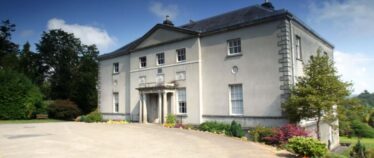New bridge over Avonmore named for Samuel Hayes of Avondale






Samuel Hayes Bridge, a new pedestrian bridge to link the Jubilee Walk and the Avonmore Way trail over the Avonmore River was officially opened in the Rathdrum area on 16th of June 2021. The new suspension bridge is designed to have the look and feel of a walking trail footbridge that is light and transparent. Wicklow County Council, in conjunction with Coillte and the National Parks and Wildlife Service collaborated on the project.
Samuel Hayes (1743-1795) was a member of parliament, barrister, amateur architect, antiquarian, planter and kinsman of Charles Stewart Parnell. The son of John Hayes of Hayesville, Ballytrasna, County Wicklow, Samuel commissioned James Wyatt to design Avondale House, which was built in 1777. Educated in Trinity College Dublin and Oxford, Hayes was called to the Irish bar in 1767. He became Sheriff of Wicklow in 1773 and was a colonel in the Wicklow Foresters and lietenant-colonel in the Wicklow militia. Elected MP for Wicklow borough in 1783 and Maryborough in 1790, Hayes was an active member of parliament. Among the legislation he introduced was: ‘An Act for encouraging the cultivation and better preservation of trees’ in 1788.
Forestry at Avondale
On building Avondale House, Hayes also established the Avondale forest – extensively planting trees both for timber and ornament. An active member of the Royal Dublin Society, Hayes was a man ahead of his time, believing the future lay in managed woodlands and reforestation at a time when native forests were disappearing. He wrote Ireland’s first book devoted to trees, A practical treatise on planting and the management of woods and coppices in 1794. The book was intended as a practical guide to the planting of trees and management of timber. It contains valuable information about Irish estates at that time, including details of individual trees of note, as well as charming woodcuts of woodland scenes. Indeed, all of the oldest trees still surviving on the Avondale estate were planted by Hayes.
Keen antiquarian
Like many of his contemporaries, Hayes was also a keen antiquarian and member of the Royal Irish Academy – discovering and restoring the remains of Saint Saviours Church at the Glendalough monastic site. As a talented amateur architect his principal achievement was the facade at the Irish House of Commons, now Bank of Ireland, College Green, which he designed in collaboration with James Gandon. He also designed the Market House in Monaghan and the centre bay of the former Flannel Hall in Rathdrum, as well, of course, as the famous Avondale House with the help of prominent English architect James Wyatt.
Hayesbridge
Echoing the new pedestrian bridge at the Avonmore Way, among the designs of Samuel Hayes was a wooden bridge known as Hayesbridge (depicted) – a single span wooden bridge over the Avonmore river at Avondale House. Described as a ‘geometrical or mathematical bridge’ the individual timbers were carefully calculated to form the bridge’s arc similar to one which survives at Queen’s College Cambridge (depicted).
Bequeathed to the Parnells
As Samuel and his wife Alice Le Hunte did not have children, on his death in 1795 the estate passed to his Parnell relatives on his mother’s side, and subsequently became the home of the celebrated Irish parliamentarian Charles Stewart Parnell. A fitting epitath to Samuel Hayes was written in 1801 by one of his contemporaries Robert Fraser: ‘The late colonel Hayes, a name truly endearing to all who feel the enthusiasm of extending zeal for the rural arts’.
Sources
Bowe P., ‘Samuel Hayes’ Avondale’ Irish Arts Review, SUMMER 2009, Vol. 26, No. 2
Fraser, R., General View of the County Wicklow, Dublin 1801
Johnston-Liik, M., History of the Irish Parliament, Vol 4, 2002
McCracken, E., ‘Samuel Hayes of Avondale’. Irish Forestry Journal, Vol. 25, No. 1, 1968
McGuire J. & Quinn J. (eds.), Dictionary of Irish Biography, Vol 4, 2009




Comments about this page
How was a bridge named after someone so hated in the area, a cruel military man, once killed a local man by having him dragged behind a horse from Kingston House to Rathdrum.
Good news, I was there on tuesday, a month after my last visit, and the work has all been completed and works great.
Hi Karl,
Thanks for the positive feedback on the Avonmore Way. Regarding your specific access issue/query you may to follow up directly with the Wicklow Trails office, see https://www.gov.ie/en/publication/925db9-rural-recreation-officers/#wicklow
It is a lovely bridge, which makes great access to the Avonmore Way, but access to bridge on south side of river is very difficult, especially for older walkers, as it is very unfinished, and makes it dangerous to get on the bridge.
It would not require much work to to provide a proper step up to bridge.
Thank you for taking the time to point that out. I have made that change in the article now.
Samuel Hayes did not design and build Avondale house James Wyatt did.
Add a comment about this page